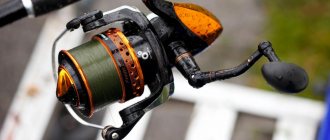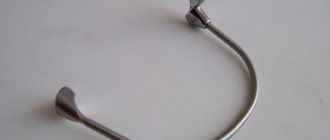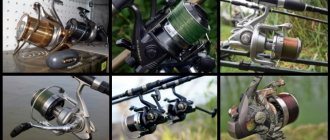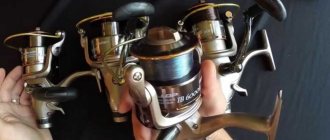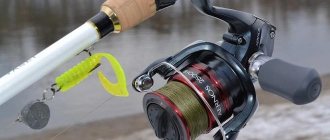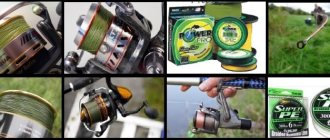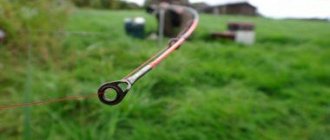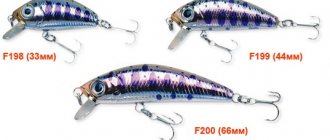Choosing a coil for a feeder is an important point when assembling feeder equipment. The low quality of this most important element of gear will significantly reduce the convenience of fishing, since the reel is not only a device for storing braid or fishing line. Its design and quality directly affects the fishing of fish, the casting distance of the equipment, the possibility of the appearance of beards, the speed of reeling, etc.
Therefore, it is important for beginners to know how to choose a coil for a feeder and what parameters to pay attention to.
Standard size
It will not be possible to select a feeder coil without taking into account the standard size. It significantly affects the balance of the entire equipment and, naturally, the comfort of fishing, and the strength of small 2000 reels for 100 gram feeders is clearly not enough.
Much will depend on the specifics of the rod itself; it is best to choose a reel along with the rod in a fishing store, but usually the size selection goes like this:
- pickers 2.1-3.3 meters - reel sizes 2500-3500 according to the Shimano classification;
- feeders 3.3–3.6 meters – models 4500-5500;
- reinforced feeder over 3.9 meters - spool 7000.
Attention: When choosing reels in a store, you must not forget that the popular fishing companies Daiva and Shimano have different size numbering.
Number of bearings
Many fishermen are confident that in this case everything is quite simple - the more bearings, the better. But it is not so. A reel for a feeder rod must have a smooth ride and a margin of safety, but products from popular manufacturers with a large number of bearings often have a very high cost.
And although most manufacturers install more than 10 bearings, only 4 are important:
- 2 support in the handle;
- on the shaft;
- in the line layer.
It is also important to remember that many Chinese designs with 10 balls perform worse than branded ones with 4 bearings.
Gear ratio
If we consider what the gear ratio on a reel is, then all products are conventionally divided into power and speed, as well as intermediate models. Power reels are used for fishing for large fish and for installing heavy springs (feeders). Such reels have an increased safety margin and, thanks to the massive mechanism, they last longer, but reeling in the tackle takes longer.
High-speed reels are characterized by a more fragile design and a shorter service life, but are very popular among athletes because they save time during competitions. Many novice fishermen purchase intermediate models.
The gear ratio can usually be seen on the body of the product, but different manufacturers may have markings on other places on the reel.
The parameters in this case are quite arbitrary, so the number 5.5:1 indicates a high-speed design: for 1 revolution of the handle, the line guide makes 5.5 revolutions. Models with ratios of 4.1:1 are considered power. And 5:1 products are intermediate, which is what beginners need to purchase.
Gear ratio is an important parameter when choosing a coil for a feeder; it is better to choose a universal option in the region of 5-5.2
Feeder coil selection parameters
Spool (reel) size
Fishing with a feeder involves long-distance casting of equipment (from 25 to 100 meters). After casting, it should be possible to quickly reel the line out of the water, so a reel size as large as possible is desirable. The large reel effectively reels out the fishing line; it contains a fairly powerful mechanism that can withstand heavy loads.
The reel size designation indicates the ability to hold 100 meters of fishing line of a certain diameter on the spool. Thus, a spool marked “2000” holds 100 meters of fishing line with a diameter of 0.2 mm, and a spool “3000” holds 100 meters with a diameter of 0.3 mm. For the feeder, coils with a size of 3000-4000 are used (even up to 8000, but not less than 2500).
Number of spools included
Some reel models may include several spools. Not all brands and not all types of reels are equipped with two or more spools. When purchasing a reel, it makes sense to pay attention to this. This allows you to use different equipment by changing the spool with braided line to a spool with monofilament line.
Spool type
It is preferable to use a shallow spool with a low profile - the lower the line is laid on the reel, the easier it will be to cast.
Low-profile models eliminate the need to prepare backing for the working line; if it is laid correctly, the side of the spool should protrude no more than 2-3 mm. Otherwise, when casting, the fishing line clings to the spool profile, the friction force holds it back, and the equipment will not reach the intended target.
Spool shape
Since most feeder rigs use braided line, it is preferable to use a reverse taper spool. Thanks to this shape, during casting the line will not fly off in whole turns, saving the tackle from getting tangled.
Gear ratio
The gear ratio is the ratio of one revolution of the handle to the number of revolutions of the line guide around the spool (accurate to decimals). It is indicated on the reel body (for example, 4.0:1 or 5.6:1).
According to this parameter, coils are divided into power and speed. If the first indicator is less than five, the coil is classified as power. High-speed reels include those whose line guide makes more than five revolutions around the spool per revolution of the handle.
The feeder requires a power coil. The best purchase options would be reels with a line layer speed of 4.6 to 5.2.
Line laying quality
It is important for a reel in feeder fishing. It is better provided by models equipped with a so-called endless screw. If there is a kind of longitudinal bulge on the back of the coil, then it is included in the design. You can also see information about the features of the coil in the technical description.
Reel weight
A comfortable reel weight for a standard fishing rod is 300-350 grams. For a picker rod, which belongs to the light class, the weight of the reel is 240-250 grams. For Heavy class rods (for fishing in rivers with medium and strong currents), a reel weighing 400-450 grams can be used.
Number of bearings
A reel designed for more than one season of use should have four to five bearings or more. Too many bearings make the reel heavier, so you shouldn’t bother with too many of them.
For feeder gear, it is fundamentally important to have four bearings in the reel:
1. Roller in the line layer;
2. Two support in the handle;
3. Rotary on the main rod.
Friction clutch
It is necessary for releasing the line from the reel with active resistance from the fish. Large prey can stretch the line or break the tackle. The drag, adjusted to a certain load, “allows” the fish to pull the line off the reel during strong jerks.
During periods when the prey calms down and stops resisting, it is pulled up, gradually bringing it closer to the surface of the water. Without a friction clutch, it will not be possible to deplete her strength. The friction brake can be located at the rear or at the front of the reel. Each type has its pros and cons.
1. Front clutch - adjusted by rotating the screw, which also serves as a spool mount. It is more convenient to use ultra-light gear.
2. Rear drag - more convenient when used in more powerful gear designed for larger fish.
3. Baitrunner - it is equipped with reels designed for catching large fish (most often carp reels have it). Accordingly, their use is advisable on carp rods.
Spool design
You need to pay attention to the material and depth of the spool. Often reels are sold with several spools included: regular plastic for fishing line, steel, used for braid.
Attention: It is recommended to choose spools with rounded steel clips, which are required to fix the braid, this allows you to ensure that the spring falls at the same distance. Small plastic triangular clips are installed on spinning reels.
But there is one nuance here. By and large, to cast feeders weighing 100 grams, feeder reels are mandatory; conventional spinning models will not be able to cope with this load.
But for picker, where the weight of the feeder is usually no more than 60 grams, spinning spinning reels can also be used along with bait. The only thing is that the clips on these spools are plastic, with sharp edges; they can damage the fishing line or braid during casting.
A lot will also depend on the shape of the spool. Feeder coils have four manufacturing options:
- Classic spool . Often the basic package includes two spools - the classic plastic AirSpool or the metal LongCast. The classic spool allows you to wind the required amount of line, and also, thanks to the long lever, makes it easier to fish for large fish.
- Anti Backlash System (reverse cone) . Allows you to avoid dropping loops, but reduces the casting distance.
- Tapered LongCast . Makes it possible to ensure long casting, but the likelihood of throwing off loops increases.
- Small AirSpool spool . Perfect for small-section fishing lines, it speeds up fishing to a certain extent, this is especially important in competitions.
Some fishermen recommend reducing the depth of the spool by winding electrical tape. This is not a very successful method - in the heat, the adhesive composition from the electrical tape will end up on the fishing line and quickly ruin it. For this, backing is used - an inexpensive fishing line that is wound under the braid.
Classic LongCast spool
Bayrunner
Feeder reels with baitrunners are a fairly popular solution offered by fishing stores. But some feederists have great doubts about the importance of this mechanism specifically for feeder fishing.
The baitrunner makes it possible to loosen the clutch in one click; this allows, for example, a carp to easily unwind the line from the reel when biting, and the fishing rod is securely on the stand. This mechanism is more in demand in carp fishing; with this fishing method, the fisherman often moves away from the rods for a long time, and bites, especially if it is a large specimen, are quite rare. In this case, the baitrunner helps you not to worry about the safety of the equipment.
Bayrunner is highly desirable on feeder reels
When fishing on a feeder, especially in the fast sports version, in some cases the fishing rod is not even installed on a stand, since casts are made more than once a minute. That is, a baitrunner is not needed in this case. When fishing at a fast pace, they simply don’t have time to use it.
But if the feeder is used for carp fishing or for catching trophy bream, when bites are not observed very often, then there is some sense in a baitrunner.
One click of the baitrunner lever makes it possible to loosen the clutch, this provides the fish with the ability to easily unwind the braid from the spool.
Do I need a baitrunner on a reel for a feeder?
A reel with a baitrunner is needed for those feeders who often (purposefully) catch large fish with a feeder, most often carp and cupid.
Carp are usually caught using the flat method using a feeder and casting less frequently. After casting, the baitrunner is turned on, and the weakly tightened rear clutch is activated. If a large fish bites, then even before hooking it can pull off a little fishing line due to the rear brake not being tightened too much.
After hooking and rotating the reel handle, the baitrunner is turned off and the front brake is activated, which is adjusted when landing fish.
If you are aiming to catch big fish, then reels with a baitrunner will be a good choice when purchasing.
TOP 10 best reels for feeder
Today on the fishing gear market, in the “feeder reel” series, there are both products from popular European and American brands, as well as domestic models.
Daiwa Laguna E3000B
The gear ratio of 5.3:1 is within the conventional norm and allows you to quickly reel in the fishing line. Together with the steel body of the reel, Daiva equipped the large gear of this model with bearings.
The main spool is aluminum, but the kit includes a spare plastic one. This universal feeder reel from Daiwa is highly durable. In addition, it has an excellent smooth ride.
But there are several drawbacks - play in the handle and difficulty in rotating the line roller.
Price – $45.
Ryobi Arctica 4000
Ryobi developed a reel that was first used by spinners, but then began to be installed on the feeder.
Arctic 4000 can withstand heavy feeders due to its design features. The durable body is made of carbon fiber and aluminum. Reel weight 320 g. The ergonomic handle is repositionable. Supplied with an aluminum spool. The reel is reliable and versatile.
The downside is that after a season the structure begins to loosen.
Price – 60$.
Shimano Stradic CI4+ C3000FB
The Shimano Stradik reel for feeder is characterized by manufacturability and light weight (190 g). The internal mechanism protection system COREPROTECT is installed, which prevents the ingress of dust and moisture.
The body of the product is made using the new G-Free Body technology. The Magnumlite rotor is lightweight and has low inertia. The reel is silent and smooth.
The disadvantages are that there is no bearing in the spool and the price.
Price – $200.
Volzhanka Meteor 3000
A good budget reel for feeder with micro-step adjustment of the friction brake. The spool is equipped with two bearings. The design uses a graphite rotor and an aluminum spool, due to which the weight of the product is only 297 g.
The maximum load that the brake system can withstand is 5 kg. 8 bearings are responsible for smooth rotation.
The disadvantages are the noise during winding and the hilliness of the cord after rewinding to the spool from the reel.
Price – $20.
Stinger Forceage Neo 3000
Joint development of Chinese and Russian engineers. First, you need to highlight the quality of winding of the fishing line and cord. The reel also has a smooth ride and a clutch made of steel and bronze. The handle and spool are aluminum. The result is a decent lightweight design (312g).
The disadvantages are that there is not enough lubrication in the reel, so it starts to make noise after a while, and the graphite on the body can crack from an impact.
Price – 60$.
Salmo Elite Baitfeeder 7 4000 BR
This model has an original brake system, which combines rear and front clutches, and is equipped with a baitrunner.
The reel has a reliable body, a comfortable handle, an attractive appearance, and a soft stroke. The kit includes an aluminum and graphite spool.
The disadvantage is its heavy weight (365 g).
Price – 40$.
Okuma Inspira ISX-30R
This is a Chinese feeder reel, in which the developers did not take the path of reducing cost, but pursued improving quality. 9 bearings are responsible for smooth running; due to excellent balancing, there is no vibration. Dust and water resistance is ensured by a sealed seal.
The disadvantage is that the fishing line sometimes gets caught between the spool and the clutch.
Price – $90.
Ryobi Excia MX3000
Thanks to many parts that are made of metal, the design is highly durable. The move is smooth, there are no backlashes, it has ideal line winding, and does not require special care. Number of bearings – 9 pieces.
Disadvantages - the kit contains one spool.
Price – $88.
Shimano 17 Ultegra C3000FB
This reel is based on the 12 Ultegra model. The brake system can withstand 9 kg, has a reliable body, smooth operation, and the line is wound without bumps.
The disadvantages are the high cost and some of the bearings are not “original”.
Price – $160.
DAIWA Fuego 5000 DC XH LT
This is an elite reel for feeder fishing. Assembled in Vietnam, high quality. Due to graphite and the latest technologies, it is lightweight (250 g). A distinctive feature is the Tough Digigear gears. This allows:
- increase service life;
- increase power;
- reduce dimensions.
Disadvantages - not identified.
Price – $110.
The best feeder reels - rating for 2021:
General approaches when choosing a coil for a feeder
The reel is an element of gear that is responsible for both casting bait over a certain distance and for the further fishing process. When choosing a reel, you should take into account many important properties and qualities, since your success in fishing will directly depend on this.
The choice of coil for the feeder should be based on:
- Places where fishing takes place. Obviously, the type of reservoir directly affects the characteristics of the reel. For long-distance casting of lures, reels with certain properties are required, for short casting - with others.
- Reliability. When fishing with feeder gear, the reel is almost constantly in action, and therefore it must be as reliable as possible. The reliability of the design is determined by the material from which the product is made and the quality of the build.
- Mechanism power. The reel must be selected depending on the traction and power indicators of the action.
- Design features. The design features of the reel determine its functionality and many other qualities.
- Ergonomics. The reel should be as comfortable and practical as possible so that its owner does not encounter difficulties and discomfort while fishing.
- Cost. Prices for feeder coils vary from several hundred rubles to several tens of thousands.
It should be noted that choosing a coil is not always done right the first time. In order to find the best option, you often have to go around several fishing stores.
Next we will talk about the design features of the feeder coil, which should definitely be taken into account by anyone who wants to choose a high-quality option.
Feeder Reel Size
The size of the reel is one of the most important indicators, which affects both the convenience of its use and the casting distance. At the moment, there are several classification options, however, the most popular among fishermen is the classification of reel size depending on the volume of the spool, the varieties of which differ in numerical value.
For designation, numbers are used that are multiples of 500. For example, if a reel is used whose spool size is 1000, this means that 100 m of fishing line with a thickness of 0.1 mm can be placed on it. If you use a fishing line of 0.05 mm, then you can wind it on the spool for 200 m. You can find out the numerical value of the reel size on the packaging or in the documentation that comes with the kit.
Reels with a spool size of 2500-3000 are considered optimal for fishing with feeder gear. If rods with increased rigidity are used, the reel size can vary between 3000-4000.
Bayrunner
Baitrunner is a function that allows you to weaken the friction brake of the reel at the necessary moments, which is especially important when fishing for large species of fish, when the load on the line is very high. A baitrunner eliminates the possibility of line breakage or rod breakage.
The bait-turner activation mechanism on most models is located on the rear panel of the reel. Using this function not only eliminates the possibility of a break, but also provides freedom of action for the fisherman. For example, after casting, having installed the feeder on the stand, the angler does not have to worry about missing a bite, since when there is a bite, the baitrunner will work, which will allow the fish to unwind the line until fishing begins.
Gear ratio
The coil reduction, or gear ratio, is also a very important indicator. It determines the number of rotations of the spool that occur with one rotation of the reel handle. For example, if the gear ratio is 4:1, this means that during one rotation of the handle the spool will rotate 4 times.
When choosing the optimal reduction rate, remember the following:
- For feeder fishing, reels are used, the reduction of which ranges from 4.6:1 to 5.5:1
- If the gear ratio of the reel is less than 4.6:1, it can be classified as a power reel, since their speed does not allow the line to be quickly reeled in, which is very important when feeder fishing. The indicator also affects the casting process.
- Reels with a gear ratio greater than 5.5:1 are considered high-speed. Such reels provide a very high line winding speed, which is also not always convenient when fishing with feeders, especially if casting over a short distance.
Reels with a reduction ratio of 4.6-5.5:1 are ideal for fishing with feeder gear, as they provide optimal line winding speed and at the same time are able to withstand significant loads.
Friction brake
The friction brake is a mandatory element of the feeder reel. Unlike the baitrunner, which is not found in every model, the drag is present on all models of feeder fishing reels. The main function of the friction brake is protection against line breakage.
In order for the friction brake to work correctly, it must be adjusted. For this purpose, special regulators are located in the front or back of the coil. When turning the regulator to the right, the breaking force increases, while turning to the left causes the braking system to weaken, due to which the line comes off even with the slightest load, which, in turn, completely eliminates the possibility of breakage.
Number of bearings
The presence of bearings in the feeder reel is mandatory. This is explained by many reasons, however, the main one is that bearings can significantly increase the durability of reel mechanisms, of which there are quite a lot due to the complexity of the design. In addition, the number of bearings largely affects the speed of rotation of the handle and other moving elements of the reel.
Based on the number of bearings, reels can be divided into the following types:
- No bearings. Such reels are absolutely not suitable for feeder fishing.
- 3-4 bearings. These models are more wear-resistant and durable.
- 7-9 bearings. Durable reels recommended for feeder fishing.
- 12 or more. They are characterized by increased durability, however, their use is not always rational.
When choosing a feeder reel with a certain number of bearings, it is recommended to pay attention to the manufacturer. It is better if the angler purchases a reel with fewer bearings, but from a reliable brand.
Price and quality
When choosing a reel, you should definitely consider its cost. Unfortunately, unlike reels for other types of fishing, feeder reels often have a higher cost. There are also cheap models, however, they are practically useless for this type of fishing.
When choosing a price category, you should be guided by several simple principles:
- It is better to buy a reel at a higher price than a cheap one that will break after several fishing attempts;
- The main parameter that has more than 50% influence on the cost of the reel is the quality of the spool;
- It is not recommended to purchase Chinese products at a favorable price, even if the described characteristics of the coil are at a high level;
- If you are purchasing your first feeder reel, it is best to buy one of the cheapest but most reliable models.
In general, both the price and quality of a feeder reel are determined by many factors, starting with the materials from which it is made and ending with the manufacturer.
Rating of high-quality budget reels for feeder
Feeder fishing is usually done for decent fish. The main load during starting feeding and during landing falls on the reel. Therefore, their choice must be approached responsibly. The rating of the best budget reels for feeder included.
GRFISH Astra 2500F
The spinning reel is characterized by beautiful appearance and durability. The body is made of composite, the spool is graphite. The reel is equipped with a front clutch. Fishermen note ease of operation and long service life. Ideal for feeder.
Advantages:
- light weight;
- reliability;
- low price;
- good quality;
- ease of use.
Disadvantages: Not defined
Price – $18.
MIKADO Inazuma 4006 FD
Reliable inexpensive model for feeder. Friction – front, number of bearings – 8 pieces. Supplied with two aluminum spools. Fishermen note the versatility, durability, and long service life of the reel.
Advantages:
- winds the line perfectly;
- high-quality assembly;
- affordable price.
Disadvantages: Cannot be used with thin braids.
Price – $23.
Salmo Sniper Baitfeeder 4 3040 BR
An excellent reel for beginners and hobbyists. Can be used for spinning and feeder fishing. Characterized by durability and ease of use. The main requirement for storage is an unscrewed clutch.
Advantages:
- graphite body;
- spare spool;
- long service time;
- quiet move.
Disadvantages: Not defined.
Price – $24.
Choosing a reel for a feeder is a rather important point; an incorrectly selected spinning reel will greatly spoil the fishing experience even with a very expensive rod.
Which feeder reel to choose?
1. For picker rods and middle-class (medium) rods, reels with a spool size of 2500-3500 are suitable;
2. For Medium and Heavy class rods, you can use a reel with a spool size of 4000;
3. For long-distance fishing and carp fishing, where Heavy and Extra Heavy rods are used, reels with 5000 and 5500 spools are suitable;
4. It is preferable to choose a reel with a rear drag; fishing with a reel of this design is more convenient;
5. Beginners who like feeder fishing can be recommended to purchase inexpensive models of different types (for example, match and spinning). This will give you the opportunity to get comfortable, then choose the most suitable and convenient option for yourself;
6. Beginners should not pay much attention to the number of bearings in the reel; to master a new type of fishing, it is enough to purchase a budget reel with four bearings.
